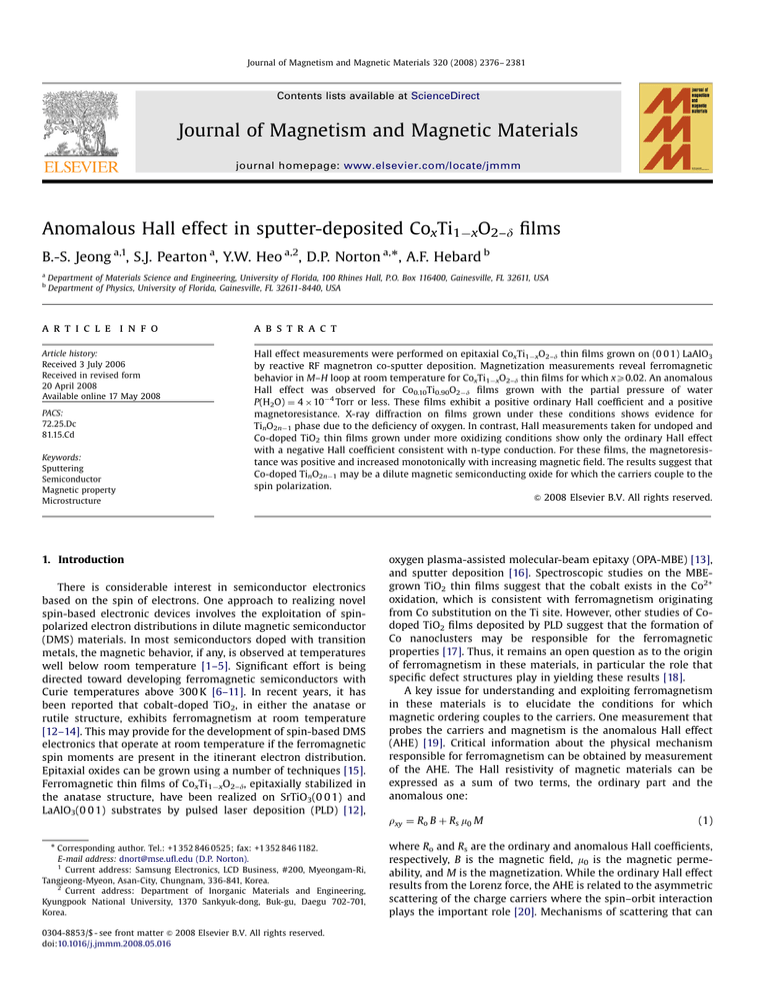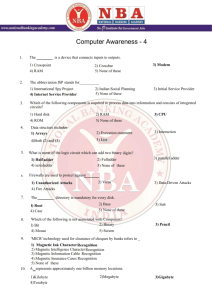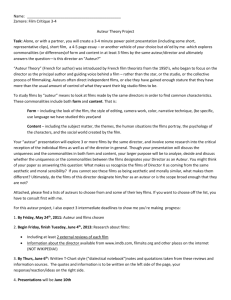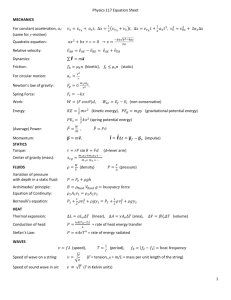
ARTICLE IN PRESS
Journal of Magnetism and Magnetic Materials 320 (2008) 2376– 2381
Contents lists available at ScienceDirect
Journal of Magnetism and Magnetic Materials
journal homepage: www.elsevier.com/locate/jmmm
Anomalous Hall effect in sputter-deposited CoxTi1xO2–d films
B.-S. Jeong a,1, S.J. Pearton a, Y.W. Heo a,2, D.P. Norton a,, A.F. Hebard b
a
b
Department of Materials Science and Engineering, University of Florida, 100 Rhines Hall, P.O. Box 116400, Gainesville, FL 32611, USA
Department of Physics, University of Florida, Gainesville, FL 32611-8440, USA
a r t i c l e in f o
a b s t r a c t
Article history:
Received 3 July 2006
Received in revised form
20 April 2008
Available online 17 May 2008
Hall effect measurements were performed on epitaxial CoxTi1xO2–d thin films grown on (0 0 1) LaAlO3
by reactive RF magnetron co-sputter deposition. Magnetization measurements reveal ferromagnetic
behavior in M–H loop at room temperature for CoxTi1xO2–d thin films for which xX0.02. An anomalous
Hall effect was observed for Co0.10Ti0.90O2d films grown with the partial pressure of water
P(H2O) ¼ 4 104 Torr or less. These films exhibit a positive ordinary Hall coefficient and a positive
magnetoresistance. X-ray diffraction on films grown under these conditions shows evidence for
TinO2n1 phase due to the deficiency of oxygen. In contrast, Hall measurements taken for undoped and
Co-doped TiO2 thin films grown under more oxidizing conditions show only the ordinary Hall effect
with a negative Hall coefficient consistent with n-type conduction. For these films, the magnetoresistance was positive and increased monotonically with increasing magnetic field. The results suggest that
Co-doped TinO2n1 may be a dilute magnetic semiconducting oxide for which the carriers couple to the
spin polarization.
& 2008 Elsevier B.V. All rights reserved.
PACS:
72.25.Dc
81.15.Cd
Keywords:
Sputtering
Semiconductor
Magnetic property
Microstructure
1. Introduction
There is considerable interest in semiconductor electronics
based on the spin of electrons. One approach to realizing novel
spin-based electronic devices involves the exploitation of spinpolarized electron distributions in dilute magnetic semiconductor
(DMS) materials. In most semiconductors doped with transition
metals, the magnetic behavior, if any, is observed at temperatures
well below room temperature [1–5]. Significant effort is being
directed toward developing ferromagnetic semiconductors with
Curie temperatures above 300 K [6–11]. In recent years, it has
been reported that cobalt-doped TiO2, in either the anatase or
rutile structure, exhibits ferromagnetism at room temperature
[12–14]. This may provide for the development of spin-based DMS
electronics that operate at room temperature if the ferromagnetic
spin moments are present in the itinerant electron distribution.
Epitaxial oxides can be grown using a number of techniques [15].
Ferromagnetic thin films of CoxTi1xO2–d, epitaxially stabilized in
the anatase structure, have been realized on SrTiO3(0 0 1) and
LaAlO3(0 0 1) substrates by pulsed laser deposition (PLD) [12],
Corresponding author. Tel.: +1 352 846 0525; fax: +1 352 846 1182.
E-mail address: dnort@mse.ufl.edu (D.P. Norton).
1
Current address: Samsung Electronics, LCD Business, #200, Myeongam-Ri,
Tangjeong-Myeon, Asan-City, Chungnam, 336-841, Korea.
2
Current address: Department of Inorganic Materials and Engineering,
Kyungpook National University, 1370 Sankyuk-dong, Buk-gu, Daegu 702-701,
Korea.
0304-8853/$ - see front matter & 2008 Elsevier B.V. All rights reserved.
doi:10.1016/j.jmmm.2008.05.016
oxygen plasma-assisted molecular-beam epitaxy (OPA-MBE) [13],
and sputter deposition [16]. Spectroscopic studies on the MBEgrown TiO2 thin films suggest that the cobalt exists in the Co2+
oxidation, which is consistent with ferromagnetism originating
from Co substitution on the Ti site. However, other studies of Codoped TiO2 films deposited by PLD suggest that the formation of
Co nanoclusters may be responsible for the ferromagnetic
properties [17]. Thus, it remains an open question as to the origin
of ferromagnetism in these materials, in particular the role that
specific defect structures play in yielding these results [18].
A key issue for understanding and exploiting ferromagnetism
in these materials is to elucidate the conditions for which
magnetic ordering couples to the carriers. One measurement that
probes the carriers and magnetism is the anomalous Hall effect
(AHE) [19]. Critical information about the physical mechanism
responsible for ferromagnetism can be obtained by measurement
of the AHE. The Hall resistivity of magnetic materials can be
expressed as a sum of two terms, the ordinary part and the
anomalous one:
rxy ¼ Ro B þ Rs m0 M
(1)
where Ro and Rs are the ordinary and anomalous Hall coefficients,
respectively, B is the magnetic field, m0 is the magnetic permeability, and M is the magnetization. While the ordinary Hall effect
results from the Lorenz force, the AHE is related to the asymmetric
scattering of the charge carriers where the spin–orbit interaction
plays the important role [20]. Mechanisms of scattering that can
ARTICLE IN PRESS
B.-S. Jeong et al. / Journal of Magnetism and Magnetic Materials 320 (2008) 2376–2381
yield an AHE include skew scattering (anisotropic amplitude of
scattered wave packet in the presence of spin–orbit coupling) and
side-jump scattering (the changes in paths of charge carrier due to
a lateral displacement) [21]. Recently, Jungwirth et al. [22]
proposed a competing mechanism for the AHE in DMS. This
theory relates the AHE to a Berry phase acquired by a quasiparticle
wave function upon traversing closed paths on the spin-split
Fermi surface. For cobalt-doped TiO2, previous results have shown
an AHE in films with the rutile crystal structure [12].
In this study, Hall effect and magnetoresistance measurement
for undoped and cobalt-doped TiO2d films have been performed.
The epitaxial thin films were grown by reactive co-sputter
deposition. The substrates were LaAlO3. The use of water vapor
(H2O) as the oxidant facilitates the formation of carriers via the
creation of oxygen vacancies [23,24]. We have previously reported
on the transport properties of transparent undoped semiconducting anatase TiO2 thin films epitaxially grown by reactive
sputtering deposition employing water vapor [24]. In this
reference, the conditions for which anatase TiO2 can be formed
were identified. The primary focus of the present study is to
investigate the Hall effect in sputter-deposited Co-doped TiO2d
films.
2. Experimental procedures
CoxTi1xO2 anatase films were epitaxially grown by reactive RF
magnetron co-sputter deposition with cation sputtering targets of
Ti (99.995%) and Co (99.95%). The total pressure during growth
was fixed at 15 m Torr, whereas the water vapor pressure ranged
from 104 to 102 Torr. Water vapor pressure was varied to
achieve oxygen deficiency and semiconductor transport behavior.
A substrate temperature during the deposition was 650 1C,
resulting in the growth of highly crystalline epitaxial Co-doped
TiO2 thin films in the anatase phase for P(H2O) similar to that
reported for undoped TiO2. The growth rate was on the order of
2 nm/min. Film thickness varied from 100 to 400 nm. The
crystalline structure of the Co-doped TiO2 films was characterized
by X-ray diffraction (XRD) with a Cu Ka radiation source.
Quantitative analysis of the chemical composition was performed
by electron probe microanalysis. To extract information regarding
chemical states of the element, X-ray photoelectron spectroscopy
(XPS) was used with Al-Ka radiation (hn ¼ 1486.6 eV). The surface
morphology and cobalt distribution were characterized by backscattered images and chemical mapping using field-emission
scanning electron microscopy. Detailed microstructure characterization was performed using transmission electron microscopy.
Room temperature magnetization was measured by a Quantum
Design superconducting quantum interference device (SQUID)
magnetometer.
For Hall measurements, both undoped and Co-doped TiO2d
thin film samples were utilized. The measurements were taken in
a physical property measurement system manufactured by
Quantum Design Inc. Two types of sequences were used to
analyze the samples. The first sequence was a magnetic field
sweep from 6 to +6 T, while the temperature was kept constant.
The following temperatures were chosen for magnetic field
sweeps: 100, 200, and 300 K. The second was a temperature
sweep between 10 and 300 K, holding the magnetic field constant
at values of 0 and 1 T.
2377
exhibited crystalline quality similar to that seen in previous work
on undoped films. The films are near single-phase epitaxial
anatase with a small amount of secondary rutile phase seen in
some of the XRD data. From the in-plane and out-of-plane XRD
measurements, the anatase lattice parameters were a ¼ 3.790 Å
and c ¼ 9.495 Å. For cobalt doping greater than or equal to 2%,
hysteretic loops are observed in the magnetization measurements
at room temperature. Saturation magnetization increased with
increasing Co content. These results are consistent with both the
MBE and PLD results reported earlier [12,13]. The magnetic
moment was relatively low (0.25 mB per Co ion) at saturation as
compared to that found for MBE-grown films. The spontaneous
magnetic moment per Co atom derived from the saturated
magnetization in MBE-grown films was reported to be 0.6 mB
[19,25].
In sputter-deposited cobalt-doped films, the surfaces occasionally include secondary phases. The microstructural properties
of the particles have been examined and reported elsewhere [26].
Cross-section electron microscopy reveals that a significant
fraction of the cobalt can segregate into Co–Ti–O secondaryphase particles. However, selected area electron diffraction shows
that the secondary-phase particles are not cobalt metal, but
cobalt-rich anatase. This has been observed by others [27]. Fig. 1
shows a selected area diffraction pattern for a Co-doped TiO2 film.
No evidence is seen for cobalt metal precipitates. A detailed
description of the microstructure is reported elsewhere [26].
While the cobalt is concentrated in the segregated particles, local
energy dispersive spectrometry indicates that Co is also distributed throughout the film. The XPS results for the sputterdeposited Co-doped TiO2 films are consistent with the Co existing
in the +2 formal oxidation state in these sputter-deposited
CoxTi1xO2–d anatase thin films.
Fig. 2 shows magnetic field dependence of the Hall resistivity,
rxy, at 300 K for an undoped TiO2 thin film grown on LaAlO3(0 0 1)
substrates at 650 1C under water vapor of 103 Torr. The negative
linear slope indicates n-type majority carriers in the TiO2 matrix.
The Hall coefficient, which is independent of the magnetic field,
was 2.7 cm3/C at 300 K. Fig. 3a shows the Hall resistivity results
for a Co0.02Ti0.98O2d thin film grown at 650 1C under water vapor
of 103 Torr. Contributions to the Hall resistivity due to the AHE,
rAH, can be difficult to distinguish from the ordinary part,
rOH ¼ R0 B. It is expected that the anomalous part of rxy, which
A(002)
A(202)
A(200)
B=[010]
3. Results and discussion
Co-doped epitaxial TiO2 anatase films realized for a growth
temperature of 650 1C and water vapor pressure at 103 Torr
Fig. 1. Selected area diffraction of Co-doped TiO2 film showing only the anatase
phase with no evidence for cobalt metal precipitates.
ARTICLE IN PRESS
2378
B.-S. Jeong et al. / Journal of Magnetism and Magnetic Materials 320 (2008) 2376–2381
600
TiO2 on LaAlO3(001)
800
400
600
0
-200
-400
-600
100 K
400
ρxy (μΩ-cm)
ρxy (μΩ-cm)
200
200 K
RH=-2.7cm3/C
-1
300 K
0
-200
RH(cm3/C)
-400
-3.87(100K)
-2.58(200K)
300K
-600
-800
-2
200
0
1
Magnetic Field(μ0H/T)
-2.21(300K)
-800
2
-2
Fig. 2. The Hall resistivity result for undoped TiO2 thin films.
2
50
40
100 K
Co0.02Ti0.98O2
30
xy
( Ω -cm)
20
10
200 K
0
-10
ρ
is proportional to magnetization, would be most significant for
lower magnetic field, whereas the ordinary part of rxy, which is
proportional to the inverse of n, dominates the measurements at
higher magnetic field [28]. In particular, the slope of rxy(B) at high
fields would be dictated by the ordinary Hall effect. To extract
anomalous Hall contributions from the ordinary Hall voltage, the
Hall effect measurement was performed over a wide range of
magnetic fields. From Eq. (1), the first term denotes ordinary Hall
effect and the second term denotes the AHE, where the latter term
dominates over the former term in typical ferromagnetic
materials. With the ordinary Hall effect dominant, a small
nonlinear AHE term, if present, could be extracted by subtracting
rOH (p H), derived from the slope at high-field behavior. If the
charge carrier is spin polarized, the Hall resistivity rxy versus B
(Bm0H) behavior should exhibit a low-field shape similar to that
for the magnetization curve. Fig. 3b shows the Hall resistivity at
lower magnetic fields for a Ti0.98Co0.02O2d film. The data are
taken at 100 and 200 K. As shown in Fig. 3b, the data shows a
linear
behavior
versus
magnetic
field.
For
multiple
Co0.02Ti0.98O2d anatase films grown at P(H2O) pressure ranging
from 4 104 to 103 Torr, no AHE contribution was observed,
suggesting that the spin–orbital interaction between electron
carriers and Co ions is weak for this Co doping level.
Fig. 4a shows the Hall coefficient and carrier density as a
function of temperature for a Co0.02Ti0.98O2d thin film. There is a
moderate increase in Hall coefficient as temperature decreases. As
such, the carrier density slowly decreases as temperature
decreases. This is consistent with degenerate semiconducting
behavior, although the carrier density remains on the order of
1018 cm3 for all temperatures considered. In addition to Hall
measurements, the field-dependent longitudinal resistance rxx(H)
was also measured. Fig. 4b shows the temperature dependence of
rxx for the Co0.02Ti0.98O2d film. At the higher temperature, the
resistivity shows a positive slope, indicating metallic behavior in a
degenerate semiconductor. A transition to insulating behavior is
observed at around 125 K. The change in slope of the resistivity in
Fig. 4b suggests carrier localization effects with decreasing
temperature given that the carrier concentration, as determined
from the Hall measurements, decreases with temperature over all
measured temperatures, whereas a change to insulating resistivity
behavior occurs at 125 K. Fig. 5 shows normalized resistance as a
function of field for undoped and Co0.02Ti0.98O2d measured at
200 K. For these doping levels, the magnetoresistance is positive
-1
0
1
Magnetic Field(μ0H/T)
-20
-30
-40
-50
-2000
-1000
0
1000
2000
Magnetic Field(Oe)
Fig. 3. The Hall resistivity as a function of magnetic field for the Co0.02Ti0.98O2d
(a) from 2 to 2 Tesla and (b) an expanded view from 0.2 to 0.2 Tesla.
and rxx(H) has a quadradic dependence on magnetic field, which
indicates a classical scattering effect as the origin. Note that the
Co0.02Ti0.98O2d show stronger magnetoresistance than undoped
anatase.
The properties of TiO2 anatase films with higher Co content
were then examined. In particular, Co0.10Ti0.90O2d thin films were
grown and characterized. For Co0.10Ti0.90O2d thin films were
grown at a water vapor pressure of 103 Torr or greater, no AHE
was observed. Hall resistivity was qualitatively similar to that
seen for the Co0.02Ti0.98O2d films. However, Hall measurements
for Co0.10Ti0.90O2d grown at lower water vapor pressure did
reveal an AHE. Fig. 6 shows magnetic field dependence of Hall
resistivity rxy(H) at 100, 200, and 300 K for a Co0.10Ti0.90O2d film
grown on LaAlO3(0 0 1) at 650 1C under P(H2O) ¼ 4 104 Torr.
The inflection in the curve at low fields indicates a non-zero value
for Rs in Eq. (1). While rOH is the only contributor for the
Co0.02Ti0.98O2d film, rAH is prominent for the Co0.10Ti0.90O2d film.
For these films, there were no segregated particles observed on
the surface of films as viewed in field-emission scanning electron
microscopy. Note that this sample contains a high density of
charge carriers as compared to that for samples grown under a
ARTICLE IN PRESS
B.-S. Jeong et al. / Journal of Magnetism and Magnetic Materials 320 (2008) 2376–2381
2379
Co0.1Ti0.9O2-δ on LaAlO3
Carrier Density
Hall Coefficient
0.9
lRHl(cm3/C)
4
2.4
2.0
Co0.02Ti0.98O2
0.6
AHE
0.3
ρxy(μΩ-cm)
Carrier Density(x1018cm-3)
2.8
0.0
300K
200K
100K
-0.3
1.6
-0.6
650°C
2
100
150
250
200
Temperature(K)
P(H2O)=4×10-4Torr
300
-0.9
-2
-1
0
1
Magnetic Field (Telsa)
1.0
2
Fig. 6. The magnetic field dependence of Hall resistivity rxy(H) at 100, 200, and
300 K for the Co0.10Ti0.90O2d grown under PH2O ¼ 4 104 Torr.
0.6
300K
200K
100K
1.0000
0.4
ρxx(H)/ρxx(0)
ρxx(Ω-cm)
0.8
0.2
0.0
0
50
150
200
250
Temperature(K)
300
350
0.9996
0.9992
Fig. 4. Measurements for Co0.02Ti0.98O2d showing (a) the Hall coefficient and
carrier density, as well as (b) the temperature dependence of rxx.
1.0025
-6
Co0.02Ti0.98O2
Undoped TiO2
-4
-2
0
2
Magnetic Field(μ0H/T)
4
6
Fig. 7. Normalized magnetoresistance (rxx(H)/rxx(0)) in zero magnetic field at
various temperature for the Co0.10Ti0.90O2d films.
1.0020
ρxx(H)/ρxx(0)
Co0.10Ti0.90O2-δ
1.0015
1.0010
1.0005
200K
1.0000
-6
-4
-2
0
2
Magnetic Field(T)
4
6
Fig. 5. Magnetoresistance data for undoped and Co0.02Ti0.98O2d obtained at 200 K.
water pressure of 103 Torr. The low resistivity reflects a higher
density of oxygen vacancies. Note that the value of rAH, given by
the offset from a linear rxy, is of the same order of magnitude as
that reported elsewhere for low conductivity (Ti,Co)O2 films [29].
Fig. 7 shows the normalized resistance (rxx(H)/rxx(0)) in zero
magnetic field at various temperatures for the Co0.10Ti0.90O2d
films. For these films, the magnetoresistance is negative and
rxx(H) decreases monotonically with decreasing temperature and
increasing magnetic field. This behavior differs from that for the
Co0.02Ti0.98O2d films where magnetoresistance was positive. Fig.
8 shows an M–H curve for Co0.10Ti0.90O2d thin films obtained at
300 K. This film clearly shows strong ferromagnetic hysteresis
behavior at room temperature. The saturated magnetization (Ms)
was 20 emu/cm3. In the case of Co-doped TiO2 in the rutile phase,
it has been shown that the AHE coincides not only with
magnetization measurements using a SQUID but also with
magnetic circular dichroism [30]. It has been suggested that the
appearance of an AHE could be attributed to spin scattering due to
ferromagnetic (cobalt) nanoparticles distributed in a non-magnetic semiconducting matrix [31]. The magnetization data in
Fig. 8 clearly have a paramagnetic component in addition to the
ARTICLE IN PRESS
2380
B.-S. Jeong et al. / Journal of Magnetism and Magnetic Materials 320 (2008) 2376–2381
Magnetization (emu/cm3)
20
10
0
-10
300K
-20
-2000
-1000
0
1000
2000
Applied Field (Oe)
Fig. 8. An M–H curve for Co0.10Ti0.90O2d thin films. Magnetic field was applied
parallel to the film surface.
LAO
intensity (arb. units)
10
LAO
8
* *
LAO
P(H2O) = 10-4 Torr
*
*
*
106
A(004)
R1
R2
P(H2O) = 10-3 Torr
104
P(H2O) = 10-2 Torr
102
20
30
40
50
2θ (deg.)
60
70
80
Fig. 9. The X-ray diffraction patterns for TiO2d films deposited with 15 mTorr Ar
as a function of water vapor pressure. The anatase (A) and rutile peaks are
indicated, with R1 ¼ rutile (2 0 0) and R2 ¼ rutile (111). The asterisks indicate the
TinO2n1 phase peaks.
ferromagnetic response as indicated by the hysteresis. However,
the absence of Co metal clusters in cross-section TEM images and
selected area electron diffraction patterns suggests that this is not
the case in the films considered in this work. Note, however, that
the sign of the Hall coefficient is positive for the Co0.10Ti0.90O2d
thin films that exhibit the AHE. While a negative Hall coefficient is
expected for n-type TiO2 anatase, a positive Hall coefficient has
been seen in TinO2n1 phase materials and may explain this
behavior [32]. In particular, the Hall coefficient for single-crystal
Ti2O3 has been measured to be positive [33]. While the TinO2n1
phase was not always observed in the XRD patterns, previous
work has shown the appearance of the TinO2n1 phases for highly
reducing conditions during sputter deposition of Ti–O. XRD scans
for TiO2d films grown at different water vapor pressures shown
in Fig. 9 suggests that anatase grown under lower water vapor
pressure tends to favor the formation of a TinO2n1 phase. Given
the density of diffraction peaks observed for these triclinic phases,
it is not possible to unequivocally identify which phase is present.
The most likely candidates are Ti4O7 and Ti6O11. It has been shown
that sub-oxide thin films of the Ti–O systems can be produced
with sputter deposition through control of the oxygen partial
pressure during growth [34]. The negative magnetoresistance is
similar to that seen in transition metal-doped Ti2O3. In particular,
it was reported that the ferromagnetism and a negative
magnetoresistance were observed in Cr-doped Ti2O3 films [35].
Without Cr doping, the magnetoresistance was positive. It was
suggested that bound magnetic polarons could explain the
observed behavior. In this model, an exchange interaction of
localized carriers with magnetic ions produces bound magnetic
polarons [36]. In an applied magnetic filed, the magnetic
moments of the magnetic ions tend to align in the direction of
the applied field. This increases the mobility of the carriers and
yields a negative magnetoresistance.
The appearance of magnetic behavior in both magnetization
and Hall resistivity is consistent with a model in which
magnetism in Co-doped TiO2 anatase is a macroscopic property
unrelated to precipitates, but the AHE does appear to correlate
with growth conditions for which the formation of TinO2n1
defects is favored. The enhancement of ferromagnetism via
growth of transition metal-doped TiO2 in reduced atmosphere
has been observed elsewhere [37]. Ferromagnetism in Cr-doped
TiO2 is reportedly induced by growth at lower oxygen pressure
that induces oxygen vacancies [37]. Others have even reported
ferromagnetism in reduced TiO2 with no transition metal dopants
[38–40], although this behavior for undoped material was not
observed in the limited sample set considered in our study. It
should be noted that ferromagnetism has been observed in
insulating TiO2 anatase in which the magnetic behavior was
dependent on oxygen vacancies [41]. Dependence of ferromagnetism on carrier density has been observed for other transition
metal-doped semiconducting oxides [42], although the mechanism remains an open question. It has been proposed that
ferromagnetic ordering in Co-doped TiO2 occurs due to superexchange between transition metal/oxygen vacancy complexes
that are stabilized by charge transfer [43,44]. More work is needed
in order to delineate the mechanism(s) for ferromagnetism in
these materials.
4. Conclusions
The ordinary Hall effect is dominant over the undoped and
Co0.02Ti0.98O2d thin films. For each of these films, the magnetoresistance is positive and increase monotonically with increasing magnetic field. The AHE contribution is present for the
Co0.10Ti0.90O2d grown under lower water vapor pressure that
tends to favor the formation of the TinO2n1 phase. The results
suggest that Co-doped TinO2n1 may be a dilute magnetic
semiconducting oxide in which the carriers couple to the spin
polarization.
Acknowledgements
This work was partially supported by the Army Research Office
through research grant DAAD 19-01-1-1508 grant and by the NSF
under grant No. 0404962 (AFH). The authors would also like to
acknowledge the staff of the Major Analytical Instrumentation
Center, Department of Materials Science and Engineering, University of Florida, for their assistance with this work.
References
[1] S. Datta, B. Das, Appl. Phys. Lett. 56 (1990) 665.
ARTICLE IN PRESS
B.-S. Jeong et al. / Journal of Magnetism and Magnetic Materials 320 (2008) 2376–2381
[2] S.A. Wolf, D.D. Awschalom, R.A. Buhrman, J.M. Daughton, S. Von Molnar, M.L.
Roukes, A.Y. Chechelkanova, D.M. Treger, Science 294 (2001) 1488.
[3] J.M. Kikkawa, J.A. Gupta, I. Malajovich, D.D. Awschalom, Physica E 9 (2001)
194.
[4] Y.D. Park, A.T. Hanbicki, S.C. Erwin, C.S. Hellberg, J.M. Sullivan, J.E. Matson, T.F.
Ambrose, A. Wilson, G. Spanos, B.T. Jonker, Science 295 (2002) 651.
[5] H. Ohno, F. Matskura, T. Omiya, N. Akiba, J. Appl. Phys. 85 (1999) 4277.
[6] S.J. Pearton, C.R. Abernathy, D.P. Norton, A.F. Hebard, Y.D. Park, L.A. Boatner,
J.D. Budai, Mater. Sci. Eng. R-Rep. 40 (2003) 137.
[7] K. Ip, R.M. Frazier, Y.W. Heo, D.P. Norton, C.R. Abernathy, S.J. Pearton, J. Kelly, R.
Rairigh, A.F. Hebard, J.M. Zavada, R.G. Wilson, J. Vacuum Sci. Technol. B 21
(2003) 1476.
[8] N.A. Theodoropoulou, A.F. Hebard, D.P. Norton, J.D. Budai, L.A. Boatner, J.S. Lee,
Z.G. Khim, Y.D. Park, M.E. Overberg, S.J. Pearton, R.G. Wilson, Solid-State
Electron. 47 (2003) 2231.
[9] T. Dietl, H. Ohno, F. Matsukura, J. Cibert, D. Ferrand, Science 287 (2000) 1019.
[10] S.J. Pearton, C.R. Abernathy, G.T. Thaler, R.M. Frazier, D.P. Norton, F. Ren, Y.D.
Park, J.M. Zavada, A. Buyanova, W.M. Chen, A.F. Hebard, J. Phys.-Condens.
Matter 16 (2004) R209.
[11] J.M.D. Coey, Curr. Opin. Solid State Mater. Sci. 10 (2006) 83.
[12] Y. Matsumoto, M. Murakami, T. Shono, T. Hasegawa, T. Fukumura, M.
Kawasaki, P. Ahmet, T. Chikyow, S.-Y. Koshihara, H. Koinuma, Science 291
(2001) 854.
[13] S.A. Chambers, S. Thevuthasan, R.F.C. Farrow, R.F. Marks, J.U. Thiele, L. Folks,
M.G. Samant, A.J. Kellock, N. Ruzycki, D.L. Ederer, U. Diebold, Appl. Phys. Lett.
79 (2001) 3457.
[14] C.E.R. Torres, A.F. Cabrera, L.A. Errico, S. Duhalde, M. Renteria, F. Golmar, F.H.
Sanchez, Phys. B-Condens. Matter 398 (2007) 219.
[15] D.P. Norton, Mater. Sci. Eng. R-Rep. 43 (2004) 139.
[16] B.S. Jeong, Y.W. Heo, D.P. Norton, J.G. Kelly, R. Rairigh, A.F. Hebard, J.D. Budai,
Y.D. Park, Appl. Phys. Lett. 84 (2004) 2608.
[17] D.H. Kim, J.S. Yang, K.W. Lee, S.D. Bu, T.W. Noh, S.-J. Oh, Y.-W. Kim, J.-S. Chung,
H. Tanaka, H.Y. Lee, T. Kawai, Appl. Phys. Lett. 81 (2002) 2421.
[18] S.J. Pearton, C.R. Abernathy, G.T. Thaler, R. Frazier, F. Ren, A.F. Hebard, Y.D.
Park, D.P. Norton, W. Tang, M. Stavola, J.M. Zavada, R.G. Wilson, Phys. BCondens. Matter 340 (2003) 39.
[19] Y. Matsumoto, R. Takahashi, M. Murakami, T. Koida, X.-J. Fan, T. Hasegawa, T.
Fukumura, M. Kawasaki, S.-Y. Koshihara, H. Koinuma, Jpn. J. Appl. Phys. 40
(2001) L1204.
2381
[20] H. Ohno, Science 281 (1998) 951.
[21] L. Berger, G. Bergmann, in: C.L. Chien, C.R. Westgate (Eds.), The Hall Effect and
its Applications, Plenum, NewYork, 1979, p. 55.
[22] T. Jungwirth, Q. Niu, A.H. MacDonald, Phys. Rev. Lett. 88 (2002) 207208.
[23] B.-S. Jeong, D.P. Norton, J.D. Budai, G.E. Jellison, Thin Solid Films 446 (2004)
18.
[24] B.-S. Jeong, D.P. Norton, J.D. Budai, Solid-State Electron. 47 (2003) 2275.
[25] S.A. Chambers, C.M. Wang, S. Thevuthasan, T. Droubay, D.E. McCready, A.S.
Lea, V. Shutthanandan, C.F. Windisch Jr., Thin Solid Films 418 (2002) 197.
[26] B.-S. Jeong, Y.W. Heo, D.P. Norton, A.F. Hebard, Physica B 370 (2005) 46.
[27] J.S. Pan, J.W. Chai, S.J. Wang, J.G. Tao, C.H.A. Huan, Int. J. Mod. Phys. B 22
(2008) 63.
[28] Y. Yamada, H. Toyosaki, A. Tsukazaki, T. Fukumura, K. Tamura, Y. Segawa, K.
Nakajima, T. Aoyama, T. Chikyow, T. Hasegawa, H. Koinuma, M. Kawasaki, J.
Appl. Phys. 96 (2004) 5097.
[29] R. Ramaneti, C. Lodder, R. Jansen, Appl. Phys. Lett. 91 (2007) 012502.
[30] H. Toyosaki, T. Fukumura, Y. Yamada, M. Kawasaki, Appl. Phys. Lett. 86 (2005)
182503.
[31] S.R. Shinde, S.B. Ogale, J.S. Higgins, H. Zheng, A.J. Millis, V.N. Kulkarni, R.
Ramesh, R.L. Greene, T. Venkatesan, Phys. Rev. Lett. 92 (2004) 166601.
[32] A. Afir, M. Achour, N. Saoula, J. Alloys Compd 288 (1999) 124.
[33] J.M. Honigm, T.B. Reed, Phys. Rev. 174 (1968) 1020.
[34] K.G. Geraghty, L.F. Donaghey, Thin Solid Films 40 (1977) 375.
[35] Z. Wang, J. Tang, L. Spinu, J. Appl. Phys. 97 (2005) 10D319.
[36] P.A. Wolff, R.N. Bhatt, A.C. Durst, J. Appl. Phys. 79 (1996) 5196.
[37] X. Zhang, W.H. Wang, L. Li, Y.H. Cheng, X.G. Luo, H. Liu, J. Phys. D-Appl. Phys.
41 (2008) 015005.
[38] A.K. Rumaiz, B. Ali, A. Ceylan, M. Boggs, T. Beebe, S.I. Shah, Solid State
Commun. 144 (2007) 334.
[39] S.D. Yoon, V.G. Harris, C. Vittoria, A. Widom, J. Phys.-Condens. Matter 19
(2007) 326202.
[40] S.D. Yoon, Y.J. Chen, A. Yang, T.L. Goodrich, X. Zuo, K. Ziemer, C. Vittoria, V.G.
Harris, J. Magn. Magn. Mater. 309 (2007) 171.
[41] K.A. Griffin, A.B. Pakhomov, C.M. Wang, S.M. Heald, K.M. Krishnan, J. Appl.
Phys. 97 (2005) 10D320.
[42] M. Ivill, S.J. Pearton, D.P. Norton, J. Kelly, A.F. Hebard, J. Appl. Phys. 97 (2005)
053904.
[43] G. Cohen, V. Fleurov, K. Kikoin, J. Appl. Phys. 101 (2007) 09H106.
[44] K. Kikoin, V. Fleurov, Phys. Rev. B 74 (2006) 174407.




